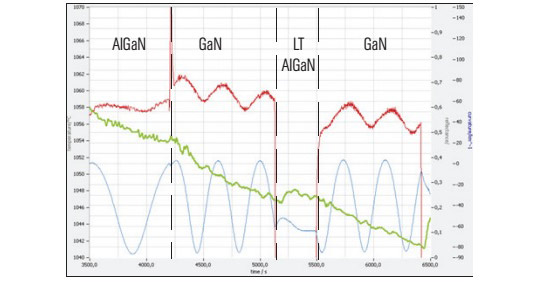Temperature measurement during metal-organic chemical vapor deposition (MOCVD) growth of GaN-on-silicon (GaN/Si) devices is challenging, notes in-situ metrology system maker LayTec AG of Berlin, Germany. Theoretically, conventional infrared (IR) pyrometry should be sufficient because the silicon substrate is IR absorbing in the full range of relevant growth temperatures. However, one artifact makes feedback control difficult and prohibits precise statistical process control in industrial applications. Figure 1 shows this phenomenon: when GaN is grown, the temperature signal (red) starts oscillating by ±2K.
Fig. 1: GaN/Si template run for creating a compressively pre-strained buffer (as can be seen in the curvature data): red – temperature; green – curvature; blue – reflectance (950nm). Data courtesy of Otto-von-Guericke University of Magdeburg.
Together with partners at Otto-von-Guericke University of Magdeburg (professor Armin Dadgar and his team) and FBH (Ferdinand-Braun-Institut, Leibniz-Institut fur Hoechstfrequenztechnik) of Berlin, Germany (Dr Frank Brunner), LayTec searched for a solution and found out that, no matter how perfect the IR pyrometer is, these oscillations are inevitable. They are caused by a complex interaction between two effects: on the one hand the IR-transparent GaN/AlGaN strain-engineering layers together with the defect-reducing buffer structure, and on the other hand the thermal IR radiation out of the silicon wafer that passes through the grown structure. LayTec's solution was to use a pyrometry wavelength range in which the complex buffer layer structure Si/AlGaN/GaN/LT-AlGaN/GaN is not 'visible' for the pyrometer.
Fig. 2: Overgrowth of template of Figure 1 with GaN in a planetary G3 reactor: the blue - UV pyrometry, red - Ir pyrometry, black - reflectance (950nm) temperature of the GaN buffer measured by Pyro 400 (lower blue curve) is completely free of Fabry-Perot oscillations. The IR temperature (red) again shows oscillations but (even more essential) it is also downshifted by -15K from the true temperature of its GaN surface. Data courtesy: FBH.

Using LayTec's ultraviolet (UV) pyrometer Pyro 400 (developed some years ago for GaN-on-sapphire growth in the LED industry), the results are shown in Figure 2. The same wafer as in Figure 1 was transferred to a reactor at FBH equipped with two in-situ tools: the Pyro 400 for UV pyrometry and the EpiCurve TT for IR pyrometry (950nm emissivity corrected), reflectance and wafer bow measurements. The UV pyrometer (Figure 2 - blue) gives a very stable wafer temperature signal without oscillations during GaN growth. Measurements on a reference GaN/GaN wafer in the same run (not shown here) verified that both the IR pyrometer and the Pyro 400 are well calibrated and give exactly the same temperature on an ideally flat and smooth GaN/GaN wafer. Figure 2 shows UV pyrometry measurements clearly indicating that the true GaN surface temperature of the GaN/Si template wafer is ~5K lower than that of the basically flat GaN/GaN wafer due to the ~100km-1 convex bow of the silicon template measured by EpiCurve TT.
Furthermore, it became clear that the remaining oscillations in the IR pyrometry signal (red) are not the most important artifact. Due to interactions of the thermal IR radiation with the internal structure of the GaN/Si buffer, there is an additional downshift in this temperature signal by as much as approximately 15K.
This effect is attributed to the fact that the thermal IR radiation coming out of the silicon suffers intensity losses while passing the highly defective region at the Si/GaN interface. These internal stray light losses depend on the Fabry-Perot resonance within the total GaN thickness and, therefore, also contribute to the IR temperature oscillations.
A scientific paper with a detailed root cause analysis will be published later this year, says LayTec.





